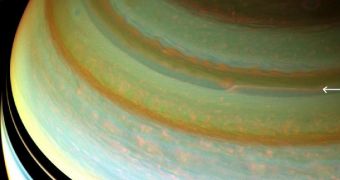Experts at the NASA Jet Propulsion Laboratory (JPL) in Pasadena, California, announce the discovery of a massive jet stream in the thin atmosphere surrounding the icy Saturnine moon Enceladus. The jet was produced by the highly active geysers located at the celestial body's south pole.
These geysers are located inside tiger-stripe-like features that were first detected by the NASA Cassini spacecraft. The vehicle has been studying the gas giant, its ring system and its moons since achieving orbital insertion around Saturn, on July 1, 2004.
What is interesting about the new study is that the plumes of organic material and water-ice vapors that are released through the geysers are not directly responsible for the jet streams. Researchers believe that the latter derive their energy from heat stored at the core of Enceladus.
This heat vents through the polar tiger stripe features, driving what little atmospheric activity is visible above the moon's surface. A jet stream is defined as an area where winds blow at much higher speeds than normal, and where these winds change direction east to west and vice-versa suddenly.
By using several years’ worth of data collected by Cassini, the JPL group has recently been able to compile a paper showing that heat derived from within the moon is responsible for driving these jet streams. The mechanisms involved in their operation were a mystery until only recently.
Details of the new investigation were published in the June issue of the esteemed journal Icarus.
According to atmospheric scientists, the internal heat of Enceladus – which is caused by the moon's interactions with Saturn – is driving water condensation, which in turn creates temperature differences in the atmosphere. The last-named then go on to spur the formation of eddies.
Eddies on Enceladus are disturbances in the air mass that are capable of moving back and forth at the same latitudes. These formations interact readily with the jet streams, accelerating the latter like rotating gears accelerate a conveyor belt.
In Earth's own atmosphere, the eddies are driven by heat from the Sun. Experts first thought that a similar mechanism was at play on Enceladus as well, but Cassini data do not support this hypothesis.
“We know the atmospheres of planets such as Saturn and Jupiter can get their energy from only two places: the Sun or the internal heating. The challenge has been coming up with ways to use the data so that we can tell the difference,” Tony Del Genio explains.
He holds an appointment as a member of the Cassini imaging team, and as a researcher at the NASA Goddard Institute for Space Studies (GISS), in New York. The expert was also the lead author of the Icarus paper.
“Understanding what drives the meteorology on Saturn, and in general on gaseous planets, has been one of our cardinal goals since the inception of the Cassini mission," adds Carolyn Porco.
“It is very gratifying to see that we're finally coming to understand those atmospheric processes that make Earth similar to, and also different from, other planets,” she adds. Porco is the leader of the Cassini imaging team, and is based at the Space Science Institute (SSI), in Boulder, Colorado.

 14 DAY TRIAL //
14 DAY TRIAL //